

Hyundai Kona EV tested: The whirring grin
The Hyundai Kona EV is fully electric and made for the city. After 800 kilometres over land and mountains, one thing is clear: a likeable car without overly wild ambitions.
The Hyundai Kona is a vehicle that divides opinion. Some like the front headlights, which are narrow and LED-equipped. Others think that the front doesn't work at all. Some think that the world has been waiting for the Kona. Others claim that the Hyundai is as superfluous as an ice cream after two hours in a car parked in summer. And Marvel thinks that the car is worthy of advertising branding with the superhero Iron Man. The fact is: everyone has an opinion on the Kona. It is definitely not a crossover SUV that is simply ignored.
So who should you believe? Is Marvel right and the Kona survives the destruction of a city? Probably not. But that's not what he's made for. Not really. I still have a bone to pick with the Marvel edition anyway, but first I'm going to get behind the wheel of the Kona EV and drive a few kilometres. 841 kilometres, to be precise.
Manoeuvrable, but made for the city
The console between the driver and passenger seats is pleasant. It is wide and separates the driver from the front passenger. This creates a strange feeling of privacy. It's the width that makes the difference. There's no gear stick. Where other automatic and electric vehicles rely on a lever to the right of the steering wheel or a gear stick with P, R, N, D and L, the Hyundai does it this way: there are four buttons. P, N, D and R. That's a bit strange for the first few metres when manoeuvring in the car park of Auto Kunz, where there are a lot of new and beautiful cars. I don't want to drive into anything and I know better gearshift systems. The gear stick is my favourite, followed by the lever to the right of the steering wheel. It gives me more haptic feedback and not just the push of a button.
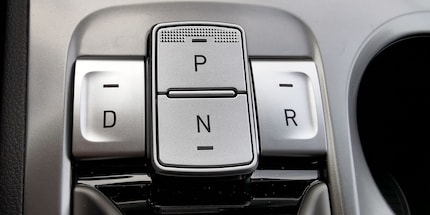
Luckily, though, the Kona is quite manoeuvrable despite its wide rear end and bonnet, which looks far more massive and longer from the Cockpit than it actually is. Honestly, if you think you're in the front of the car park wall, you've usually got at least another 20 centimetres of space. But be careful with this advice. Especially when parking in reverse, because the rear is a bit bulkier than you think, which raises questions about the surprisingly small boot. The sensors, which like to make a lot of noise, help to ensure that you don't drive into anything. In general, parking is a joy with the Kona. I'm not the greatest parker of all time, but apart from oddly positioned chargers, I don't even have to think "The parking space is already annoying".
Despite the manoeuvrability, I have a suspicion: Is the steering a bit lame? Somehow, even before driving on a public road, I feel like I'm turning and manoeuvring the wheel quite a lot. On the other hand, I'm careful around the Mustangs and other Konas. But as soon as I'm in traffic, this impression is not confirmed. On the open road, I discover Eco mode and Sport mode. Eco mode drastically changes the Kona's handling. In Sport mode, little happens apart from a little more shaking. I prefer Comfort mode. It's well balanced and pleasant. I drive in Eco mode in traffic jams, as I like to have the few extra metres of range that the regenerative braking gives me on the battery.
The Kona is not only available as an electric vehicle (EV). It also comes as a diesel. The diesel also does one thing right that the EV does wrong: the radiator grille. I don't understand that with the Tesla Model 3, I don't understand it with the Kona and I certainly don't understand it with the 1991 Mazda MX 5. The round, closed front is simply ugly. What's wrong with the colour and texture accent provided by a radiator grille?
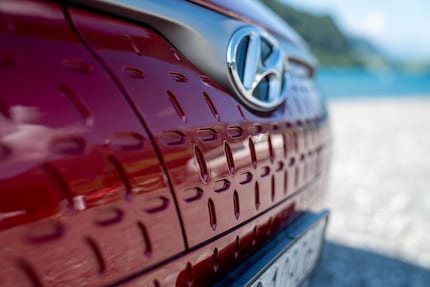
Of course, with an electric car you no longer need the radiator grille to this extent, but that doesn't mean it has to go. BMW is doing it right. The iNext and the i3 both have radiator grilles that give the car a nice front end. With the Kona, which exists in diesel and EV, I don't understand the design change. It's a waste of money.
There is one reason that makes the EV attractive. A reason that is so attractive, in fact, that I give the cooler away: The driving.
A car for the city
It's obvious that the Kona is made for the city, even if the top feature for Zurich traffic jam drivers - adaptive cruise control - is either missing or very well hidden. In general, the cruise control is complicated to operate. Just like with petrol cars - press the button, then pull down the lever on the steering wheel - which is why I gave it up completely after the second journey. It's much easier, as the cruise controls of the ancient Seat Altea and the Tesla prove. But the Hyundai is smart enough to understand that you want to drive at 50 km/h. Or 30 km/h. Or 120 km/h. Then it stops. Or 30, or 120, in which case the Kona maintains this speed and is nowhere near as tricky as the Tesla, which likes to hop around at plus/minus 5 km/h and thus comes dangerously close to the speed trap triggering speed.
A few days after my first time in the driver's seat, I decide to go for a drive. Because I think testing a car in the city of Zurich is a crazy concept. I can drive a clutch anywhere. I swear at people enough in the office and at least they can hear me there. Even in the city, I've noticed that the Kona is a really peaceful car. Although it has the equivalent of 204 hp under the bonnet, the Kona weighs 1818 kilos. Its diesel sister weighs 400 kilos less, but only produces 120 hp on three cylinders.
Like all electric vehicles, the EV has impressive acceleration. It may take a whopping 7.6 seconds from 0-100, but the electric car effect is there: press the pedal down, you're pressed into the seat and you're already a good way down the road. And no matter how much you doubt the coolness of electric cars, they never stop being fun. On the motorway, the city car is a solid performer, but it doesn't really fire up when accelerating from 80 to 120 or so. I never doubt that the Kona can't keep up and give far more powerful petrol cars a run for their money, but it's clear that, purely in terms of driving experience, the Kona prefers to cruise around town rather than on motorways.
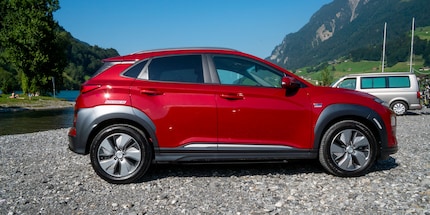
Other than that, it drives rather comfortably. The steering is soft and the shock absorbers are designed to minimise the sensation of movement. Except in the countless roadworks that the city and canton of Zurich are so fond of that they think they have to build everywhere. I'm sure we drivers think that's great too. Spoiler: We don't. Merci, gell.
The Kona hums off. That's actually good. But terrible. Because electric vehicles have one problem in common: you can't hear them. This has two extremely unpleasant effects
- Other road users can't hear you. Pedestrians, cyclists and other drivers suddenly lack a sense with which to perceive you
- You can't hear your own engine. This can cause you to drive too fast because you can't hear the engine revving too high
That's why Hyundai has added an artificial whirring sound to the Kona. As it doesn't actually have a technological function, it sounds exactly the same at 120km/h as it does at walking pace. In other words, for you as a driver it is completely superfluous and annoying after about two minutes. "Vrrrrrr" with a ghost-like howl underneath. All the time. Fortunately, there's the sound system, which does a lot. Alternatively, you can simply press the button labelled "VESS" at the bottom left of the control wheel and then you're done with haunting noises. "VESS" stands for Virtual Engine Sound System, aka ghostly howling. But the car doesn't remember this setting, which makes "VESS" one of the most frequently pressed buttons in the car. But if you still want to be heard and drive with VESS, simply switch on the pretty good stereo system. Even at a low volume, you will no longer hear the ghosts.
No teeth, but a cheeky grin
I like the Kona. Very much so. It doesn't make a technological quantum leap. It doesn't show its teeth. But everything it does, it does with a cheeky grin. It whizzes cleanly back and forth in the city, likes tight bends and fast lane changes, and can keep up well on the Swiss motorway. The boot may be a little small, but the rear seat offers plenty of storage space.
The acceleration never gets boring and the Hyundai Kona is perfect for fast manoeuvres in the city where you don't want to disturb other road users. The sensitive steering, the two useful driving modes and the many chargers in the city help immensely.
One more thing: the people at Hyundai have put a lot of effort into the small details. Especially the visual design of the engine. It could have been a block of electric stuff. But no, when you open the bonnet of the Kona, you see something where the designers have really let off steam. The colours and shapes have no influence on the performance of the engine, but something like this is just nice to look at, isn't it?
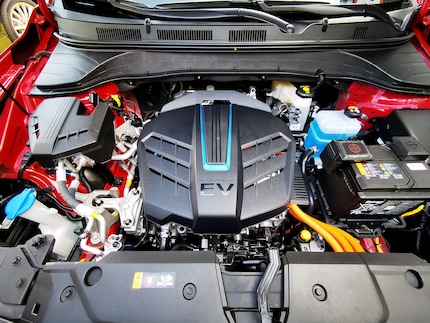
Apropos Iron Man
The Kona is available in an official Marvel-licensed Iron Man version. The car is then black with red highlights, with a "Stark Industries" logo and animations on the car's screens that are modelled on those of the Iron Man armour from the films.
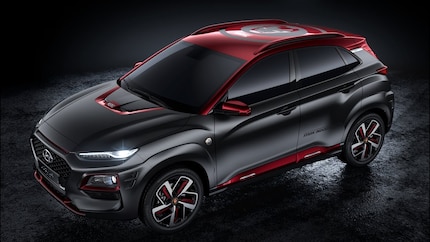
The comic book reader in me has questions.
There's the colour scheme. Iron Man was never black/red. Usually, the Marvel hero is red/yellow because the inventor Tony Stark modelled the armour on a hot rod in his garage. Then he used to be black and yellow, but that didn't last long. Otherwise there was the white space armour or the blue/white underwater armour. But no black and red. Would that have hurt Marvel/Hyundai too much if the car was red/yellow?
The only thing from Stark Industries in the comics that is black/red or black/dark blue is an armour called Detroit Steel, but it was a villain. And ugly at that. But since the Kona isn't really ugly, I don't think Detroit Steel was the inspiration.
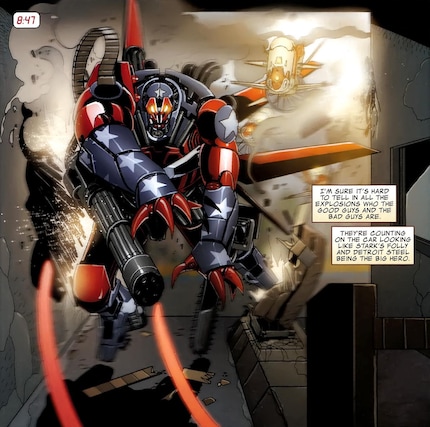
Then: Why does Iron Man's mask have to be on the roof? And then only in some vehicles and not in others? Why not just say: "This is a car as Iron Man would drive it", without the flat merchandise. It would have a bit more style and a bit less kitsch. Because Iron Man is cool. He has style and he knows how something is designed. Iron Man would never put his mask on the top of his car as a decal.
But then the Stark Industries logo on the side door... that's extremely cool again.
Journalist. Author. Hacker. A storyteller searching for boundaries, secrets and taboos – putting the world to paper. Not because I can but because I can’t not.
These articles might also interest you

Product test
A souped-up Isetta: the Microlino’s an expensive dream of driving done differently
by Michael Restin

Product test
Energica Eva Ribelle review: a glimpse of development in action
by Dominik Bärlocher

Product test
Garmin Overlander sat nav tested: old hardware, great software
by Dominik Bärlocher
